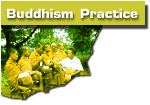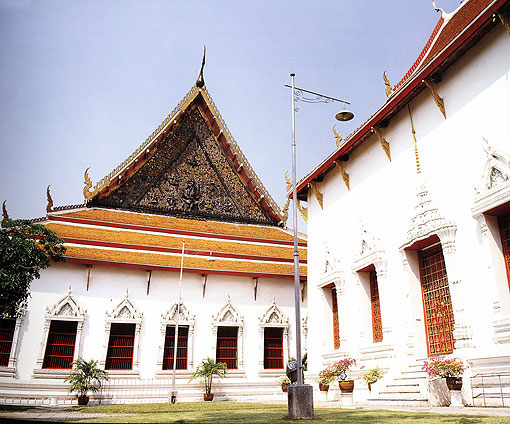 |
BANGKOK
|
||||||||
CENTRAL
|
||||||||||||
NORTHEASTERN
|
||||||||||||||
NORTHERN
|
||||||||||||
SOUTHERN
|
||||
 |
| A GUIDE TO MEDITATION CENTRES IN THAILAND |
| BANGKOK : WAT MAHATAT |
|
MEANING
OF NAME : |
"Temple
of the great element" (refers to a famouscopper pagoda) |
ALSO
SPELLED : |
Wat Mahadhatu |
ADDRESS
: |
Tha-Phrachan, Bangkok 10200 |
DIRECTIONS
: |
Located
west of Sanam Luang (parade grounds) and south of the National Museum
and Thammasat University. Mainentrances are on the west side from Maharaj Road. Manycity buses pass by |
TELEPHONE
: |
0-2222-6011
(Section 5) 0-2222-4981 (Section 5 secretary) 0-2222-2835 (Dhamma Vicaya Hall) |
MEDITATION
SYSTEM : |
Vipassana using techniques similar to those taught byMahasi Sayadaw. Based on Four Foundations ofMindfulness described in the Maha Satipatthana Sutta. Concentrationis developed on the rise and fall of the abdomen, then awareness is directed to physical and mental sensations. |
TEACHING
METHOD : |
Individual
daily interviews. Weekly lectures in Thai (usually on Sundays). Most meditation instruction and practice takes place in Section 5. |
TEACHERS
: |
Ajahn
Maha Sawai Nanaviro (Thai; age 35) Ajahn Phramaha Boonchit (Nanasangvaro)
(Thai; age 34). Other experienced monks and laypeople assist. Ajahn Phramaha Suphap Khemarangsi (Thai; age 45) is head of Section 5. |
LANGUAGE
: |
Teachers
and some assistants in Section 5 can speak a little English, though
instruction is normally given in Thai. If no one speaks English when you visit, ask at the Dhamma Vicaya Hall. |
DESCRIPTION
: |
Large, busy temple of 50 rai (20 acres). Founded in the18th century, Wat MahaThat serves as an important center for Thai Buddhism. Many of the monks attend Mahachulalongkorn Buddhist University here. Crowds of worshippers visit the various viharns, shrines, chedis, and Buddha images on the grounds. Monks in the Dhamma Vicaya Hall sometimes speak English and can answer questions; scheduled talks are given here. Meditation takes place in Section 5; you're welcome to join in on the group sitting and walking sessions. |
SIZE
: |
Monks
300-400 (one of the largest populations in Thailand during the Rains
Retreat) (30-50 monks in Section 5) Novices 50-70 (about 10 in Section 5) Nuns 10-12 (about 8 in Section 5) Laypeople about 550 (30-40 in Section 5) |
DAILY
ROUTINE : |
In Section 5 630 a.m. breakfast; 7-11 a.m. morning chanting (about 30 min.) and sitting and walking group meditation; 1130 a.m. lunch; 1-4 p.m. sitting and walking group meditation; 4 p.m. drinks; 6-8 or 9 p.m. evening chanting (about one hour) and sitting and walking group meditation. |
FOOD
: |
Good quality and variety. A simple breakfast in early morning, then the main meal in late morning; drinks are served in the afternoon. Meditators can alsoarrange for food, including vegetarian, to be delivered from shops. |
ACCOMMODATIONS
: |
Laypeople
usually stay in dormitories, separate for men and women; conditions
tend to be crowded. Monks,novices, and some laymen have individual
rooms. Electricity and running water. Bathing is from jars or showers; Asian-style toilets. |
WRITE
IN ADVANCE? : |
Not necessary. |
OTHER
INFORMATION : |
Laypeople
follow 8 precepts and normally wear white clothing. Mahachulalongkorn Buddhist University Bookstore, facing the street on the north side of the wat, has some English books on Buddhism; other Buddhist bookstores are on the same street. |
| Select here : |
|
|
